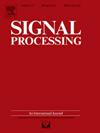Enhanced channel estimation for double RIS-aided MIMO systems using coupled tensor decompositions
IF 3.4
2区 工程技术
Q2 ENGINEERING, ELECTRICAL & ELECTRONIC
引用次数: 0
Abstract
In this paper, we consider a double-RIS (D-RIS)-aided flat-fading MIMO system and propose an interference-free channel training and estimation protocol, where the two single-reflection links and the one double-reflection link are estimated separately. Specifically, by using the proposed training protocol, the signal measurements of a particular reflection link can be extracted interference-free from the measurements of the superposition of the three links. We show that some channels are associated with two different components of the received signal.Exploiting the common channels involved in the single and double reflection links while recasting the received signals as tensors, we formulate the coupled tensor-based least square Khatri–Rao factorization (C-KRAFT) algorithm which is a closed-form solution and an enhanced iterative solution with less restrictions on the identifiability constraints, the coupled-alternating least square (C-ALS) algorithm. The C-KRAFT and C-ALS based channel estimation schemes are used to obtain the channel matrices in both single and double reflection links.We show that the proposed coupled tensor decomposition-based channel estimation schemes offer more accurate channel estimates under less restrictive identifiability constraints compared to competing channel estimation methods. Simulation results are provided showing the effectiveness of the proposedalgorithms.
基于耦合张量分解的双ris辅助MIMO系统增强信道估计
本文考虑了双反射(D-RIS)辅助平衰减多输入多输出系统,并提出了一种无干扰信道训练和估计协议,其中两个单反射链路和一个双反射链路分别进行估计。具体来说,通过使用所提出的训练协议,可以从三个链路的叠加测量中提取特定反射链路的无干扰信号测量值。利用单反射链路和双反射链路中涉及的共同信道,同时将接收信号重铸成张量,我们提出了基于耦合张量的最小平方卡特里-拉奥因式分解(C-KRAFT)算法,这是一种闭式解法,也是一种对可识别性约束限制较少的增强迭代解法,即耦合替代最小平方(C-ALS)算法。我们的研究表明,与其他竞争性信道估计方法相比,基于耦合张量分解的信道估计方案在可识别性约束较少的情况下提供了更精确的信道估计。仿真结果表明了所提算法的有效性。
本文章由计算机程序翻译,如有差异,请以英文原文为准。
求助全文
约1分钟内获得全文
求助全文
来源期刊

Signal Processing
工程技术-工程:电子与电气
CiteScore
9.20
自引率
9.10%
发文量
309
审稿时长
41 days
期刊介绍:
Signal Processing incorporates all aspects of the theory and practice of signal processing. It features original research work, tutorial and review articles, and accounts of practical developments. It is intended for a rapid dissemination of knowledge and experience to engineers and scientists working in the research, development or practical application of signal processing.
Subject areas covered by the journal include: Signal Theory; Stochastic Processes; Detection and Estimation; Spectral Analysis; Filtering; Signal Processing Systems; Software Developments; Image Processing; Pattern Recognition; Optical Signal Processing; Digital Signal Processing; Multi-dimensional Signal Processing; Communication Signal Processing; Biomedical Signal Processing; Geophysical and Astrophysical Signal Processing; Earth Resources Signal Processing; Acoustic and Vibration Signal Processing; Data Processing; Remote Sensing; Signal Processing Technology; Radar Signal Processing; Sonar Signal Processing; Industrial Applications; New Applications.
 求助内容:
求助内容: 应助结果提醒方式:
应助结果提醒方式:


